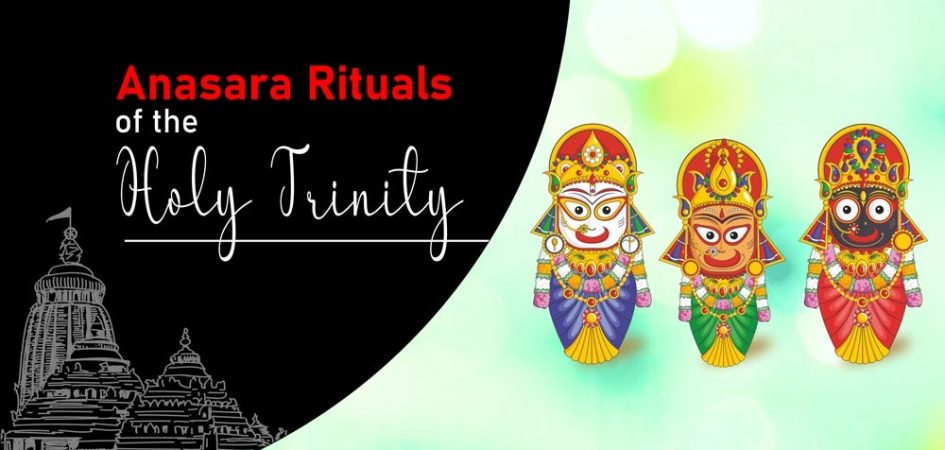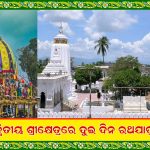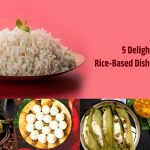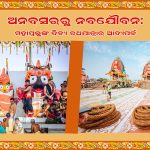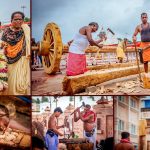To beat the summer heat, the temple’s Deities take a bath with 108 pots of cold water during the bathing festival (Deva Snana Purnima). The three Deities become ill after this royal bath ceremony, and they must withdraw from public view for a period of 15 days. This is known as the ‘Anasara’ or ‘Anavasara’ period, which begins with Jyestha purnima and concludes with Ashadha amavasya.
Here are all the rituals that go on during the 15-days of Lord Jagannath’s quarantine:
Patti Dians: Praying to the Pattachitra Alternatives
When the divine trinity is in anasara, colourful pattachitra paintings of the Gods are worshipped in the temple. These paintings depict Lord Jagannath as Lord Vishnu, Lord Balabhadra as Lord Shiva and Devi Subhadra as Adishakti.
Mangala Alati & Abakasha Niti: Beginning the Morning with Cleanliness & Worship
There is an auspicious lighting of lamps in the morning which is followed by brushing of teeth, bathing and cleaning of the Gods. During the Abakash Puja, astrological readings of the day are also made.
Sakala Dhupa: Preparing Delicious Delicacies to feed the Gods
The morning bhoga of the day is called the Sakala Dhupa. The Raja Bhoga consists of dishes like Kachudi, Kanika, Dal, Vegetable Curries, Pitha, Jhilli, etc.
Bhoga Mandapa & Madhyanaa Pahuda: Rest Time for the Divine
The Bhoga Mandapa is a larger continuation of the Sakala Dhupa. This is followed by a brief time for the deities to rest. The period (generally between 1:30 – 2:00 PM) is called Madhyana Pahuda.
Anasara Pindi: Medication Begins for the Holy Trinity
This is the period when the Bhoga offered to the God is to heal them. It involves medicines such as Jhuna, Kaintha Atha and other herbs. The Daitapatis ensure the healthiest of treatment for the Holy Trinity.
Phuluri Tela: Application of fragrant oils for the Gods’ Protection
For their supreme care, fragrant oils extracted mainly from Sesame and other flowers like Ketaki, Malli, Boula and Champa, are applied to the Gods. The oils protect them from insects and moths and are prepared by Bada Odia Mutt (the Adi Pitha of Atibadi Jagannath Das).
Khadilagi Ekadasi: Renewing the Idols of the Lords
During the current period of time, the idols of Lord Jagannath, Lord Balabhadra and Devi Subhadra are checked minutely as they are made of wood. This is followed by Khadilagi Ekadasi on which day, a new coat of primer, locally known as Khadi, is applied on the idols.
Chaka Bije Niti: The Gods Regain their Strength
On the day of Dasami, the Gods are said to feel better. Hence, all the rituals carried on this day mainly mark them regaining their balance. They are said to be healthy enough to sit properly on the wheels.
Raja Prasad Bije Niti: Informing the Gajapati about the Health of the Gods
Raja Prasad Bije, as the name suggests, is the day when Gajapati Maharaja (the first servitor of the Lord Jagannath), is informed. The Daitapatis take all the items of the Lords to the Maharaja and inform him that the Gods have been cured.
Ghana Lagi: Tying of the Ropes to the Gods’ Idols
On Trayodashi, 10-12 hours of the day are dedicated to tying Ghana to the idols of the deities. Ghana is generally made of ropes and the ritual of tying it is called Ghana Lagi.
Banakalagi: Brightening the Idols with Paint
Hingula, Haritala, Kasturi, Keshar, glue of Kaintha are natural substances that are used to make fresh bright paint for the Idols. The Banaka obtained is used to polish the face of the deities. During the period of this ritual, no devotee is allowed to see the idols.
Kasturi Nabhi: More Protection & Better Colours, all the way from Nepal
The rare Kasturi Nabhi is only found in Nepal. The King of Nepal, who is also a sevak of Lord Jagannath, allows getting the Kasturi Nabhi from Nepal so that it can be mixed with the chemical-free colours during the painting process so as to protect the idols from insects.
Nabajauban Darshan: Fresh, Healthy & Happy Gods are Decked Up!
After days of recuperating and resting, once the Gods are fully cured, on the day of Amavasya, they are decked up in the best poshaks and appearances. On this day, the gods are fit and healthy enough to flaunt their rejuvenated youth to their devotees.
All of these rituals lead up to the culmination of events that precede Rath Yatra, the biggest festival of Odisha. Devotees look forward to witnessing the Lord of the Universe in his complete grandeur. It is uncertain whether devotees will be allowed to witness these rituals of ansara this year, unlike the last two years due to the COVID-19 pandemic.
Let’s hope the Gods have a speedy recovery and pray for their complete wellness!
To beat the summer heat, the temple’s Deities take a bath with 108 pots of cold water during the bathing festival (Deva Snana Purnima). The three Deities become ill after this royal bath ceremony, and they must withdraw from public view for a period of 15 days. This is known as the ‘Anasara’ or ‘Anavasara’ period, which begins with Jyestha purnima and concludes with Ashadha amavasya.
Here are all the rituals that go on during the 15-days of Lord Jagannath’s quarantine:
Patti Dians: Praying to the Pattachitra Alternatives
When the divine trinity is in anasara, colourful pattachitra paintings of the Gods are worshipped in the temple. These paintings depict Lord Jagannath as Lord Vishnu, Lord Balabhadra as Lord Shiva and Devi Subhadra as Adishakti.
Mangala Alati & Abakasha Niti: Beginning the Morning with Cleanliness & Worship
There is an auspicious lighting of lamps in the morning which is followed by brushing of teeth, bathing and cleaning of the Gods. During the Abakash Puja, astrological readings of the day are also made.
Sakala Dhupa: Preparing Delicious Delicacies to feed the Gods
The morning bhoga of the day is called the Sakala Dhupa. The Raja Bhoga consists of dishes like Kachudi, Kanika, Dal, Vegetable Curries, Pitha, Jhilli, etc.
Bhoga Mandapa & Madhyanaa Pahuda: Rest Time for the Divine
The Bhoga Mandapa is a larger continuation of the Sakala Dhupa. This is followed by a brief time for the deities to rest. The period (generally between 1:30 – 2:00 PM) is called Madhyana Pahuda.
Anasara Pindi: Medication Begins for the Holy Trinity
This is the period when the Bhoga offered to the God is to heal them. It involves medicines such as Jhuna, Kaintha Atha and other herbs. The Daitapatis ensure the healthiest of treatment for the Holy Trinity.
Phuluri Tela: Application of fragrant oils for the Gods’ Protection
For their supreme care, fragrant oils extracted mainly from Sesame and other flowers like Ketaki, Malli, Boula and Champa, are applied to the Gods. The oils protect them from insects and moths and are prepared by Bada Odia Mutt (the Adi Pitha of Atibadi Jagannath Das).
Khadilagi Ekadasi: Renewing the Idols of the Lords
During the current period of time, the idols of Lord Jagannath, Lord Balabhadra and Devi Subhadra are checked minutely as they are made of wood. This is followed by Khadilagi Ekadasi on which day, a new coat of primer, locally known as Khadi, is applied on the idols.
Chaka Bije Niti: The Gods Regain their Strength
On the day of Dasami, the Gods are said to feel better. Hence, all the rituals carried on this day mainly mark them regaining their balance. They are said to be healthy enough to sit properly on the wheels.
Raja Prasad Bije Niti: Informing the Gajapati about the Health of the Gods
Raja Prasad Bije, as the name suggests, is the day when Gajapati Maharaja (the first servitor of the Lord Jagannath), is informed. The Daitapatis take all the items of the Lords to the Maharaja and inform him that the Gods have been cured.
Ghana Lagi: Tying of the Ropes to the Gods’ Idols
On Trayodashi, 10-12 hours of the day are dedicated to tying Ghana to the idols of the deities. Ghana is generally made of ropes and the ritual of tying it is called Ghana Lagi.
Banakalagi: Brightening the Idols with Paint
Hingula, Haritala, Kasturi, Keshar, glue of Kaintha are natural substances that are used to make fresh bright paint for the Idols. The Banaka obtained is used to polish the face of the deities. During the period of this ritual, no devotee is allowed to see the idols.
Kasturi Nabhi: More Protection & Better Colours, all the way from Nepal
The rare Kasturi Nabhi is only found in Nepal. The King of Nepal, who is also a sevak of Lord Jagannath, allows getting the Kasturi Nabhi from Nepal so that it can be mixed with the chemical-free colours during the painting process so as to protect the idols from insects.
Nabajauban Darshan: Fresh, Healthy & Happy Gods are Decked Up!
After days of recuperating and resting, once the Gods are fully cured, on the day of Amavasya, they are decked up in the best poshaks and appearances. On this day, the gods are fit and healthy enough to flaunt their rejuvenated youth to their devotees.
All of these rituals lead up to the culmination of events that precede Rath Yatra, the biggest festival of Odisha. Devotees look forward to witnessing the Lord of the Universe in his complete grandeur. It is uncertain whether devotees will be allowed to witness these rituals of ansara this year, unlike the last two years due to the COVID-19 pandemic.
Let’s hope the Gods have a speedy recovery and pray for their complete wellness!
